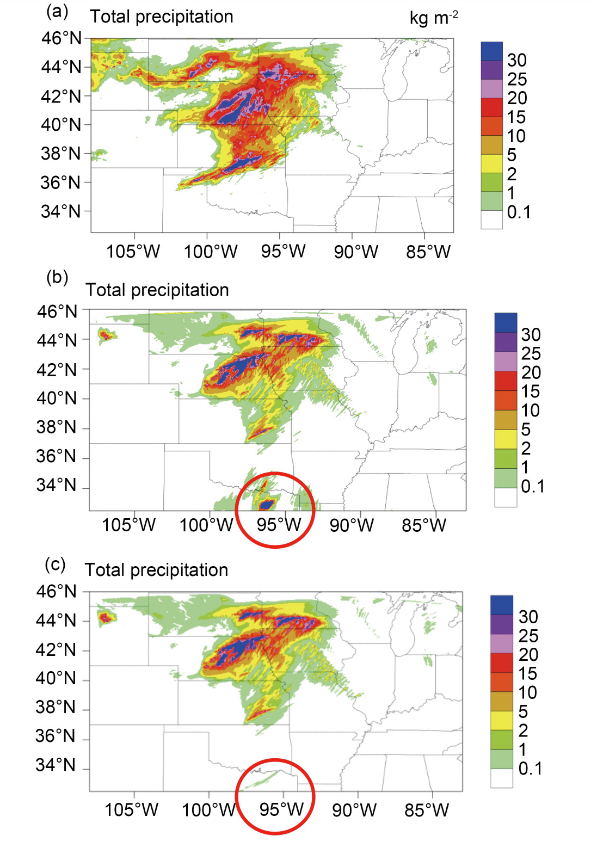
[ Archive ]

 |
CIMSS-NOAA Weekly Report [ Archive ] |
 |
CIMSS AND ASPB WEEKLY HIGHLIGHTS FOR THE WEEK ENDING JUNE 4, 2021
PRODUCTS AND APPLICATIONS:
AWARDS AND RECOGNITION:
PUBLICATIONS:
Paper Published on the Value of a Geostationary Infrared Sounder: A manuscript titled "Added-value of GEO-hyperspectral Infrared Radiances for Local Severe Storm Forecasts Using the Hybrid OSSE Method" has been published in Advances in Atmospheric Sciences (https://rdcu.be/clMZp). The added-value from a GEO-hyperspectral infrared (IR) sounder is studied and discussed using the hybrid Observing System Simulation Experiment (OSSE) method. The simulated GEO hyperspectral IR radiances are validated and the hybrid OSSE system is verified before the impact assessment, and two local severe storm (LSS) cases from 2018 and 2019 are used to evaluate the value-added impacts from the GEO hyperspectral IR sounder. The impact studies show improved atmospheric temperature, moisture, and precipitation forecasts, along with some improvements in the wind forecasts. The domain-wide improvement for moisture fields is approximately 16% and the improvement in horizontal winds is around 3%, even though wind information was not directly assimilated. The assimilation of geostationary high-spectral resolution infrared observations will have large impacts on the atmospheric thermodynamic information associated with LSS. CIMSS coauthors are Pei Wang, Zhenglong Li and Jun Li (corresponding author), NESDIS/STAR coauthor is Tim Schmit. (T. Schmit, E/RA2, 608-263-0291; J. Li, CIMSS)
 (Click image to enlarge)
(Click image to enlarge)
Figure: The 6-h accumulated precipitation of (a) Stage IV, (b) CNTRL, and (c) EXP [with GEO hyperspectral IR information] from 0600 UTC May 27 to 1200 UTC 27 May 2019. The results are based on the 24-h forecast starting at 0600 UTC 27 May 2019. The red circle shows a spurious storm in the CNTRL that formed over Texas, but was eliminated with the additional information from the Geo sounder.
WORKSHOPS, CONFERENCES, AND MEETINGS:
TRAINING AND EDUCATION:
Satellite Virtual Science Fair 1st Place Projects Announced: The 2021 GOES 16/17 Virtual Science Fair for students in grades 6-14 wrapped up in late May and the top projects were announced this week. The high school team hailed from Montgomery Blair High School in Silver Spring, Maryland and the winning middle school project came from Medford Memorial in New Jersey. The student posters and presentations can be viewed at http://cimss.ssec.wisc.edu/education/goesr/1stPlace2021.html. (M. Mooney, CIMSS, margaret.mooney@ssec.wisc.edu)
Presentation to Local 4-H Group: Scott Lindstrom from the Cooperative Institute of Meteorological Satellite Studies (CIMSS) gave a 30-minute Zoom presentation to Digital Doers, a 4-H group in Madison WI. The talk focused on memorable events in Madison weather over the past 38 years, such as the cold outbreak in 1983, the snows of 15 December 1987 and 3 December 1990, the heat of July 1995, the rain of early November 2003 and the extraordinary warmth of March 2012. The presentation was followed by a question and answer session. (S. Lindstrom, CIMSS, 608 263 4425)
MEDIA AND OUTREACH:
SSEC and CIMSS Scientists in the News: Scientists at the University of Wisconsin-Madison (UW) Space Science and Engineering Center (SSEC) and the Cooperative Institute for Meteorological Satellite Studies (CIMSS) provide expert interviews, imagery and case studies to promote science. This week: 1) CIMSS scientist Eva Borbas has developed the VIIRS Fusion Moisture Product that combines measurements from the Cross-track Infrared Sounder (CrIS) and the Visible Infrared Imaging Radiometer Suite (VIIRS) as a way to continue the moisture record from MODIS. "Continuing the MODIS legacy," by SSEC News, describes the process and product: https://www.ssec.wisc.edu/news/articles/13699/. 2) CIMSS Satellite Blog contributors Scott Bachmeier published case studies on "Above-Anvil Cirrus Plumes in Texas" (June 2) and "Ice motion in Norton Sound, and an aircraft dissipation trail over the North Slope of Alaska" (May 28-29). Read more: https://cimss.ssec.wisc.edu/satellite-blog/. (J. Phillips, SSEC, 608-262-8164, E. Borbas, CIMSS, E. Verbeten, SSEC, S. Bachmeier, CIMSS)
 (Click image to enlarge)
(Click image to enlarge)
Figure: GOES-17 captured inbound and outbound ice motion in Norton Sound, an inlet of the Bering Sea, on May 28, 2021. It was likely driven by tidal motions within the Sound. Read the CIMSS Satellite Blog post: https://cimss.ssec.wisc.edu/satellite-blog/archives/40991. Credit: CIMSS.
OTHER:
| Archived Weeklies Page | Submit a report item |